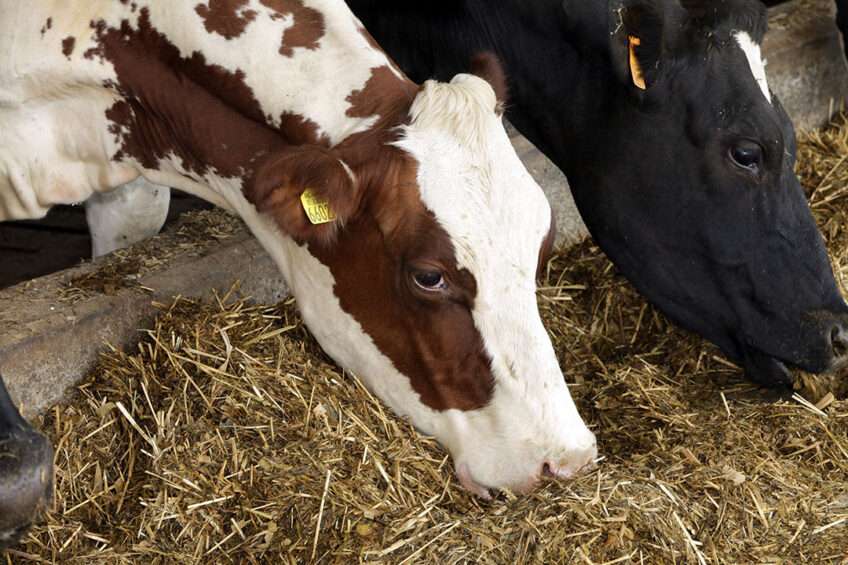Dairy cows: Top 5 sustainable approaches to protein nutrition

The symbiotic relationship between the dairy cow and the rumen microbial population is the cornerstone of ruminant nutrition.
When the microbiome is managed well, we can successfully improve dairy production but it can be somewhat of a balancing act. That is particularly true for protein nutrition of dairy cows. With increasing focus on nitrogen management regulations, it is critical that precision protein nutrition becomes the norm in sustainable dairy rationing.
Protein efficiency of ruminant diets are in the region of 16 – 40%. Nutritionists reading this will find the figure ‘16%’ painfully low, in the knowledge of the cost of protein ingredients. Poor rationing for protein can be a costly business but as well as that, it also results in increased nitrogen (N) excretion.

On the not too distant horizon, there are regulations coming into place regarding N management in dairy systems, most prominently in the Netherlands. No longer should a 18% crude protein diet be the average. Research and practical applications have shown that it is possible to take the CP% to within the region of 15% without compromising performance. Nutritional models such as INRA and CNCPS enable prediction of performance from lower CP% diets and aid in improving protein efficiency. As well as formulation approaches, there are a number of ways to improve protein efficiency in dairy production. Here are top 5 approaches to improving protein efficiency.
 Feeding protected protein meals
Feeding protected protein meals
Protected protein meals have been around for a number of years and have played an important role in maximising dairy productivity. In Europe, they have recently come under a new spotlight regarding the sustainability of soybean meals. As such there has been a greater interest in protected rapeseed (canola) meal which can be around double the bypass protein level vs an unprotected meal. These bypass proteins are likely to be an important ingredient in the future of sustainable dairy production in Europe.
 Buffer feeding at grass
Buffer feeding at grass
In countries that grow grass well, there is often a greater challenge of protein efficiency and N excretion. Grass contains a lot of rumen degradable protein (RDP). This protein is easily broken down and, if not balanced with sufficient fermentable carbohydrates, microbial protein synthesis will not be optimal.
Grass is an important economically favourable source of nutrition in dairy diets and its use should be maximised, particularly in temperate climates, however close attention should be given not to over supply RDP and under supply fermentable energy.
 Feed additives working with the rumen microbiome
Feed additives working with the rumen microbiome
Many new innovations in ruminant nutrition are likely to come from applications of working with the rumen microbiome. As analytical techniques become more available, the world of dairy nutrition will take advancements towards more intelligent working with the rumen microbiota, impacting not just performance but sustainability and health also. An area of interest within this subject lies within essential oils. Essential oils are volatile compounds that have antimicrobial effects. They can be used in blends to reduce proteolytic activity in the rumen and are used as a method of balancing the rumen for protein and energy, increasing bypass protein and reducing waste.
 Increase pasture use: Steps to success
Increase pasture use: Steps to success
Here we dive into the latest findings on how to increase use of pasture and explore and face the challenges that come with it.
 Rumen protected fats and N utilisation
Rumen protected fats and N utilisation
Recent interesting work from Wageningen University has investigated energy and N partitioning in dairy cows fed high or low metabolizable protein diets. This work has also looked at the interaction of post ruminal glucogenic and lipogenic substrates (Nichols et al 2018; Nichols et al. 2019). The study found that energy from rumen inert hydrogenated palm fatty acids improved N utilisation at both high and low levels of metabolizable protein. The mechanism behind this remains unclear however it highlights that other dietary ingredients may have a role to play in protein metabolism and efficiency.
 Silage inoculants: A full – farm approach
Silage inoculants: A full – farm approach
In silage making, the presence of clostridia and enterobacteria in the silo results in dry matter (DM) losses. Adding lactic acid bacteria inoculants helps to control the fermentation process, effectively reducing DM losses. The ability to grow more milk from home grown forage will be important in the coming years. The conservation of protein and other nutrients, through reducing DM losses, place silage inoculants as an absolute ‘must have’ for the future of sustainable dairy production.
Nutrition as a science is not just about feeding the animal to get the best return. Ruminant nutrition continues to advance, revealing emerging areas in sustainable production and animal health, that give rise to opportunities for new innovations and applications.
The need for better control of N in dairy systems is rapidly approaching. It brings with it, benefits not only to the environment, but also feed cost savings. We have seen great improvements in fertilisers and slurry management over the past 10 years, and now it is the time of nutrition to take the next step towards sustainable and precision protein utilisation.
Join 13,000+ subscribers
Subscribe to our newsletter to stay updated about all the need-to-know content in the dairy sector, two times a week.










